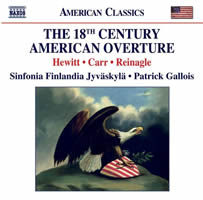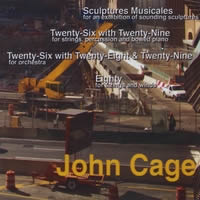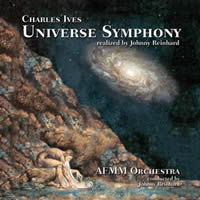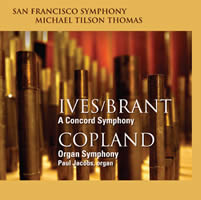Mostly Symphonies 18.
|
Grant Chu Covell [August 2011.]
“The 18th Century American Overture.” James HEWITT: Medley Overture in D minor-major (1798), New Medley Overture in C major (1799), New Federal Overture (1796). Benjamin CARR: Federal Overture (1794). Alexander REINAGLE: Miscellaneous Overture in D major (1801), Occasional Overture in D major (1794), Overture in G major (1787). Sinfonia Finlandia Jyväskylä, Patrick Gallois (cond.). Naxos 8.559654 (1 CD) (http://www.naxos.com/). The late 18th-century American musical experience during the Washington, J. Adams and Jefferson presidencies would have included medleys alternating popular tunes and Continental fare. Orchestrator and sleuth Bertil van Boer reassembled these overtures from piano arrangements and incomplete stacks of parts. These are multi-sectioned pieces whose alternately grandiose and cumbersome transitions suggest a provincial Rossini. Hewitt’s Medley Overture explicitly borrows from Mozart’s D minor piano concerto (would it have been known to his audience or is this clever reuse?). Carr’s Federal Overture includes the Marseillaise. Yankee Doodle appears so frequently you would think it the national anthem. Was Ives familiar with this tradition? Did contemporary audiences perceive a clash of high and low brows? Reinagle arrived in the US in 1786 from England, eventually settling in Philadelphia. He may be best known for his keyboard sonatas, generally agreed to be the first sonatas penned stateside. Hewitt might be recognized for his Battle of Trenton revived by Ralph Kirkpatrick. Carr also enriched Philadelphia’s musical life. Could they have imagined a Finnish troupe resurrecting their work 200 years later?
John CAGE: Three (1989)a,Twenty-Eight (1991), Twenty-Six with Twenty-Eight (1991), Twenty-Eight with Twenty-Nine (1991). Susanna Borscha (recorders), Prague Winds, Christina Fong (vln, vla), Karen Krummel (vlc), Glenn Freeman (perc), Michael Crawford (cb). OgreOgress 634479754012 (1 DVD-A) (http://www.ogreogress.com/). John CAGE: Sculptures Musicales (1989), Twenty-Six with Twenty-Nine (1991), Twenty-Six with Twenty-Eight and Twenty-Nine (1991), Eighty (1992). Prague Winds, Christina Fong (vln, vla), Karen Krummel (vlc), Glenn Freeman (perc), Michael Crawford (cb), The Chance Operations Collective of Kalamazoo. OgreOgress 634479962141 (1 DVD-A) (http://www.ogreogress.com/). Continuing our discovery of OgreOgress’ generous Cage DVD-Audio releases (the disc with Three is 2:02:06, Sculptures is 2:00:52), here are Twenty-Six (26 violins), Twenty-Nine (low strings, piano and percussion) and the brass and wind Twenty-Eight in their two- and three-part combinations. Taken alone, Twenty-Eight’s suspended tones strike one as mellower than the similar but larger wind ensemble Fifty-Eight (1992). Of the trilogy, the two string ensemble works make the strongest independent impact. Twenty-Six with Twenty-Eight aligns 26 violins with the wind ensemble and Twenty-Eight with Twenty-Nine adds winds to the low strings, percussion and piano. When combined, the shorter piece nests within the longer. In Twenty-Six with Twenty-Eight winds hide beneath spanning violins, bending the string pitches to create hallucinatory effects and unexpected beatings, suggesting a mistuned end-days organ. In Twenty-Eight with Twenty-Nine, the low strings push high notes above a steady grumble. The winds punch through like foghorns. If you’ve heard the components separately, despite the enveloping and menacing pace, Twenty-Nine’s aggression overlapped with Twenty-Eight’s coolness has the capacity to jar one’s sensibilities. By the time we encounter the icy Twenty-Six with Twenty-Nine, the pulse has slowed and the ear is primed. This assembly’s traditional string orchestra with percussion creates a commanding homogeneity. Despite the semi-spectral microtonal string tones, the musics slow pace suggests that Cage may have been aware of drone music. The Mt. Olympus congregation, Twenty-Six with Twenty-Eight and Twenty-Nine, represents 83 players, and a terrifying 29 minutes when played at a robust volume. We should applaud Cage’s planning. While some see these late number pieces as Cage expediently dispatching commissions, the results speak for themselves. A live performance rather than this elegant multi-tracking would likely produce different, perhaps uneven effects. Three is intended for a recorder trio, with two bookend movements wrapping any number of nine central sections. Program your own version. Borsch’s vibratoless tone hints at an effective organ version. One’s ears are attuned to the stacking pitches. Sculptures Musicales employs four performers with electronics, sounding here like a grab-bag of percussion, radios and battery-powered gizmos. Expanses of silence, like cosmic dropouts, stand between layer cakes of activity across its 33 minutes. One section appears to combine train noises, a toy piano and a vacuum cleaner. Eighty asks for an orchestra with lopsided winds: seven each alto flutes, English horns, clarinets, and trumpets. Strings without basses complete. Unlike the Twenty-Six–Twenty-Eight–Twenty-Nine union, Eighty’s 30 minutes sift microtonally inflected unisons and silence. The OgreOgress rendition may very well be a premiere. Despite the forces’ size, the work does not terrify.
Charles IVES: Universe Symphony (1913?-51?; realized by Johnny REINHARD, 1995). American Festival of Microtonal Music Orchestra, Johnny Reinhard (cond.). The Stereo Society SS007 (1 CD) (http://www.stereosociety.com/). Among Ives’ unfinished projects is the legendary Universe Symphony, which Henry Cowell had falsely stated as intended for an orchestra spread across two hills with an audience in a valley below. Reinhard’s persuasive realization was premiered at Alice Tully Hall in 1996, and well aware that musicologists venerate Ives, he has documented his steps in serving up more than an hour of multi-layered density. Those looking beyond the booklet summary should see Reinhard’s 2003 The Ives Universe: A Symphonic Odyssey. Others have tried to second-guess Ives, most notably Larry Austin, whose poly-stylistic collage has been twice recorded. Having revisited the Cincinnati Philharmonia release on Centaur CRC 2205, I’m convinced that Reinhard’s result lands closer to its target. Austin’s effort says more about Austin whereas Reinhard serves up Ives. This recording employs multi-tracking to achieve consistency in execution. Reinhard fashioned a six-part symphony, three sections preceded by preludes. This recording opens with a brief (1:18) fragment, Earth Alone. The largest movement is Prelude 1: Pulse of the Cosmos, an enveloping, predominantly percussion blanket stretching to 30 minutes of multiple patterns that spin and die away. When instruments appear, they paint craggy lines with microtonal inflections. Reinhold upholds Ives’ characteristically innovative thinking about intonation: B-flat and A-sharp are distinct pitches. No Civil War tunes or popular songs punch through the clotted texture. The absence of references might make this difficult to reconcile with Ives. And yet who else would ask for such wandering, errant voices. This is Ives’ attempt at a Creation myth. After the first prelude we meet movements titled Wide Valleys and Clouds, Birth of the Oceans, and Earth and the Firmament, etc. No doubt Ives would have tinkered with his Fifth forever. It most certainly would have been misunderstood in its day.
Charles IVES arr. Henry BRANT: A Concord Symphony (1958-94). Aaron COPLAND: Organ Symphony (1924). Paul Jacobs (org), San Francisco Symphony, Michael Tilson Thomas (cond.). SFSmedia SFS 0038 (1 SACD) (http://www.sfsymphony.org/). Demanding obbligato instruments and a specially sized board to play clusters, Ives’ Concord Sonata is already larger than life in its original form. Here’s the only piece that quotes Beethoven and then makes him sound completely unrecognizable. My workday commute takes me past Emerson’s house and I am routinely reminded of the sonata named after the town. Part of this opus’ power lies in its ability to defy a single player’s capabilities, the magic of which is somewhat lost when an orchestra stands in. I did not evaluate every page of Ives’ sonata, but the portions I perused (all of The Alcotts, parts of Hawthorne and Thoreau) were pretty much note-for-note transcriptions, with few extras. Ives was a master orchestrator: Witness the Fourth Symphony, Central Park in the Dark, The Unanswered Question, and almost anything else he finished. Ives knew his way around the 88 keys. The Second Sonata can be beautiful and awkward at once. We are meant to marvel at anyone who attempts it. Brant’s orchestration provides a newfound thickness that tends towards bloating. Despite the band touches and the percussion, the pileups just aren’t the same. Some results, in Emerson especially, suggest Berg’s Lulu. Michael Tilson Thomas offers a tad more briskness than did Dennis Russell Davies with the Royal Concertgebouw (Innova 414). Any Ivesian knows no two performances will play out identically. I’ve never been a MTT fan (he squeezes the life out of Revueltas and Mahler), but here the San Franciscans vastly better their Dutch counterparts. I’m sure the SACD sound has a lot to do with it. As far as I know, Copland did not live up to Walter Damroschs prediction and commit murder. Damrosch’s oft-quoted remark intended to soothe an audience unused to such modernity and jazziness at the work’s premiere, for which Nadia Boulanger crossed the ocean to play the organ part. My favorite stretch of the jaunty work lies in the Scherzo where the strings repeat an organ melody at four eighth-notes to a beat instead of the preceding three. Ives/Brant: Concord Symphony
Lewis SPRATLAN: In Memoriam (1993)1, Streaming (2004)2. Sharon Hayes1, Melinda Spratlan1 (sops), Jon Humphrey1 (ten), Donald Barnum1, Nathaniel Watson1 (bar), The Amherst College Choral Society1, The Valley Festival Orchestra1, Lewis Spratlan1 (cond.); Yvonne Lam2 (vln), David Kim2 (vla), Christian-Pierre La Marca2 (vlc), Xiang Zou2 (pno). Navona Records NV5810 (1 enhanced CD) (http://www.navonarecords.com/). I first became aware of Spratlan around the time he captured the Pulitzer for his opera Life is a Dream. His lyric dissonance suggests Berg and feisty Rochberg; his command of form appeals greatly. In Memoriam would have been welcomed around the time of the American bicentennial to remind us of our continent’s dark side. The work honors the victims of conquest, specifically the obliterated Mayans. The four movements with vocal soloists and chorus unfold as a 52-minute symphony built upon words by Pablo Neruda, César Vallejo and Mayan texts. Generally grim and reflective, the concluding Mexican Serenade and Prayer to the Sun incorporates a folksong ritornello. Despite hardship, life goes on. Today Streaming might suggest the flow of data coursing through the Internet. However, just a few years ago, Spratlan intended stream of consciousness when he labeled his piano quartet. The work proceeds intensely across a scant quarter-hour, predominantly frenzied with sparse mellow bursts.
[More Grant Chu Covell, Mostly Symphonies]
[Previous Article:
Dowland’s Lachrimae 1604]
[Next Article:
String Theory 5: Sometimes with Piano]
|





